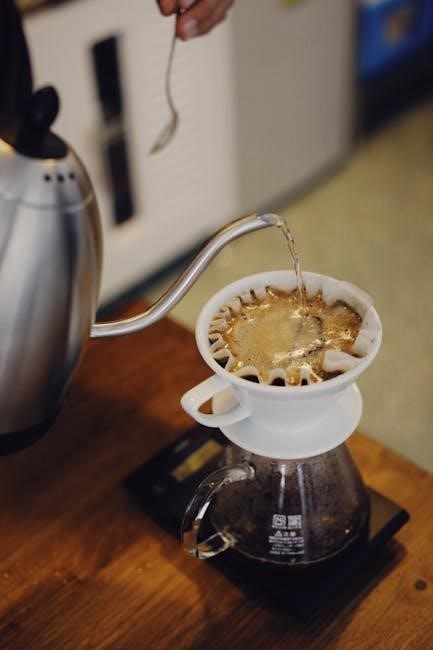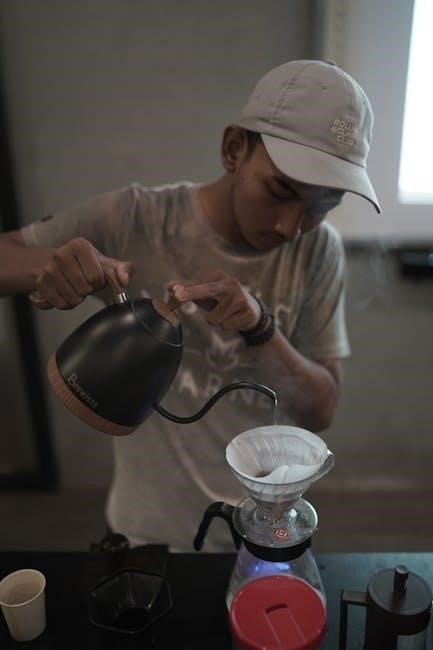Installation
1.1 Location Requirements
The giant hot water tank must be installed in a well-ventilated area, ensuring easy access for maintenance and compliance with local building codes. Placement should avoid direct sunlight and moisture exposure to prevent corrosion and overheating issues.
1.2 Connection Types
Connect the tank using approved inlet and outlet valves, ensuring proper alignment with water supply lines. Install a thermal expansion tank to manage pressure fluctuations and prevent system damage during heating cycles.
1.3 Preparation Steps
Drain the system before installation to remove debris. Ensure all connections are tight and test for leaks. Follow the manufacturer’s guidelines for pressure settings and electrical connections to ensure safe operation.
Install the giant hot water tank in a well-ventilated, easily accessible area to ensure safety and maintenance ease. The location should protect the tank from direct sunlight, moisture, and extreme temperatures to prevent overheating and corrosion. Ensure the area is level and sturdy to support the tank’s weight. Avoid placing the tank near flammable materials or in areas prone to flooding. Compliance with local building codes and regulations is mandatory. Proper spacing around the tank is essential for airflow and emergency access. Consider installing it near the main water supply line to minimize piping requirements. Ensure the tank is positioned to allow easy drainage and future servicing.
The giant hot water tank supports various connection types to accommodate different plumbing setups. Standard NPT (National Pipe Tapered) threaded connections are available for inlet and outlet pipes, ensuring compatibility with most plumbing systems. For larger systems, flanged connections provide a secure and adaptable option, especially for high-flow applications. Sanitary connections are ideal for hygienic environments, such as food processing or medical facilities, to prevent contamination. Additionally, sweat (solder) and press-fit connections can be used for smaller diameter lines, offering flexibility during installation. Always refer to the manufacturer’s guidelines to ensure compatibility and safety standards are met for your specific setup.
Before installing the giant hot water tank, ensure the site is properly prepared. Level the ground to prevent uneven installation, which could lead to instability. Move the tank carefully using a forklift or crane, as it is heavy. Unpack the tank only when ready to install, and inspect for any damage or dents. Connect the temperature and pressure relief valves according to the manufacturer’s instructions. Test the system for leaks before filling it with water. Ensure all necessary tools and materials, such as wrenches and sealants, are on hand. Follow the installation manual for specific guidelines to ensure a safe and efficient setup.

Safety Precautions
Always follow safety guidelines to prevent accidents. Handle hot water with care to avoid burns. Wear protective gear like gloves and goggles. Ensure proper pressure management to prevent explosions. Regularly inspect the system and adhere to maintenance schedules. Never overload the tank beyond its capacity. Keep the area around the tank clear of flammable materials. Follow all installation and operational instructions carefully to ensure safe and efficient performance.
2.1 Handling Hot Water
When dealing with a giant hot water tank, always exercise extreme caution to avoid burns. The water temperature can exceed 120°F, posing serious scalding risks. Use insulated pipes and proper connectors to minimize direct contact. Before performing any maintenance or adjustments, ensure the system has cooled down or been properly drained. Never touch the tank surface or nearby components without protective gear. Keep children and pets away from the area. Always test the water temperature at the faucet before use to ensure it’s safe. Mixing hot and cold water can help prevent accidental scalding. Avoid touching the tank’s exterior during operation, as it may remain hot. Use thermostats or temperature-regulating valves to control water temperature effectively. Always adhere to safety guidelines to prevent burns and injuries.
2.2 Protective Gear
Wearing proper protective gear is essential when interacting with a giant hot water tank to prevent injuries. Always use heat-resistant gloves to handle hot surfaces or pipes. Safety glasses or goggles should be worn to protect eyes from splashes or debris. A long-sleeve shirt, pants, and closed-toe shoes are recommended to minimize skin exposure. Avoid loose clothing that could catch fire or get caught in components. Use a face shield when working with pressurized systems or during maintenance tasks. Ensure all gear is in good condition and free from damage before use. Proper protective equipment reduces the risk of burns, scalds, and other accidents. Always prioritize safety.
2.3 Pressure Management
Proper pressure management is critical for the safe operation of a giant hot water tank. High pressure can lead to leaks, damage, or even explosions. Always monitor the pressure gauge to ensure readings remain within the recommended range, typically between 50-80 PSI. The pressure relief valve is a key safety component that releases excess pressure automatically. Regularly inspect the valve to ensure it functions correctly. If pressure exceeds safe levels, turn off the tank and allow it to cool before diagnosing the issue. Never attempt to adjust or repair the pressure relief valve without professional guidance. Proper pressure management ensures longevity and safety of the system.

Operation
Ensure the tank is properly installed and connected before startup. Follow the manufacturer’s guidelines for temperature settings and daily usage. Always adhere to safety precautions during operation.
3.1 Startup Procedures
Before starting the giant hot water tank, ensure the power supply is connected and the circuit breaker is switched on. Check that all valves are closed to prevent water flow during initialization. Open the cold water inlet valve slowly to fill the tank. Once filled, turn on the heating element or burner, following the manufacturer’s instructions. Set the temperature using the control panel, typically between 120°F and 140°F. Allow the tank to heat up completely, which may take 1-2 hours, depending on capacity. Monitor the pressure gauge to ensure it stays within the recommended range. After reaching the set temperature, the system is ready for use. Always refer to the manual for specific startup steps.
3.2 Temperature Settings
Set the temperature on your giant hot water tank between 120°F and 140°F for optimal performance and safety. Adjust the thermostat or control panel to your desired setting. For energy efficiency, 120°F is recommended, while 140°F may be needed for homes with high hot water demand. Always follow local regulations and manufacturer guidelines. If you have a dishwasher or washing machine requiring hotter water, ensure the setting aligns with their needs. Avoid exceeding 140°F to prevent scalding and energy waste. Check the temperature regularly to maintain consistency. Higher settings may increase energy consumption, so balance comfort and efficiency based on your household’s requirements.
3.3 Daily Usage
Ensure your giant hot water tank operates efficiently during daily use by monitoring water temperature and flow. Regularly check for leaks around connections to prevent water waste. Maintain the recommended temperature settings to balance comfort and energy savings. Insulate exposed pipes to reduce heat loss and improve efficiency. Consider installing low-flow fixtures to minimize hot water usage without compromising performance. Keep the area around the tank clear to ensure proper ventilation and access for maintenance. By following these practices, you can maximize the lifespan and performance of your giant hot water tank while reducing energy consumption.

Maintenance
Regular maintenance ensures optimal performance and longevity of your giant hot water tank. Check for leaks, clean the tank periodically, and ensure proper ventilation for efficiency.
4.1 Inspection Schedule
Regular inspections are crucial for maintaining your giant hot water tank. Schedule monthly checks for leaks, corrosion, and temperature settings. Every six months, inspect the pressure relief valve and ensure it functions correctly; Annually, check the anode rod for degradation and replace it if necessary. Additionally, examine the heating elements and electrical connections for wear or damage. Always turn off power before performing inspections. Keep a maintenance log to track inspections and address issues promptly. If unsure, consult a professional to ensure safety and compliance with manufacturer guidelines.
4.2 Drain and Flush
Draining and flushing your giant hot water tank is essential to remove sediment and ensure optimal performance. Start by turning off the power and water supply. Attach a garden hose to the drain valve, then direct the other end to a drain or outside. Open the valve to allow the tank to drain completely. Once empty, flush the tank by opening the cold water inlet to rinse out remaining debris. Repeat until the water runs clear. This process should be done every 6–12 months. Regular draining prevents corrosion and maintains efficiency. Always follow safety precautions to avoid burns from hot water during the process.
4.3 Part Replacement
Replacing parts in your giant hot water tank requires careful planning to ensure safety and system integrity. Always turn off the power and water supply before starting. Identify the faulty component, such as a heating element or thermostat, and purchase a manufacturer-approved replacement. Drain the tank partially or completely, depending on the part’s location. Isolate the component using shut-off valves if possible. Install the new part securely, ensuring all connections are tight. After replacement, flush the system to remove any debris. Keep a list of replacement parts on hand for quick access. Refer to the manufacturer’s guidelines for specific instructions and warranty considerations. Regular part replacement extends the tank’s lifespan and prevents unexpected failures.

Troubleshooting
Troubleshooting your giant hot water tank involves identifying common issues like leaks or temperature fluctuations. Follow step-by-step diagnostic procedures to pinpoint problems and apply solutions promptly.
5.1 Common Issues
Common issues with giant hot water tanks include leaks, inconsistent water temperature, and pressure buildup. Leaks often occur at connections or the tank itself due to corrosion or loose fittings. Temperature fluctuations may result from faulty thermostats or sediment buildup. Pressure issues can cause relief valves to discharge excessively. Strange noises, such as rattling or banging, may indicate sediment accumulation or loose components. Additionally, corrosion of the sacrificial anode can lead to premature tank failure. Addressing these issues promptly is essential to maintain efficiency and prevent costly repairs. Regular inspections can help identify and resolve problems before they escalate.
5.2 Diagnostic Steps
To diagnose issues with your giant hot water tank, start by checking the power supply and ensuring the tank is properly connected. Inspect the thermostat settings and verify they are correctly configured. Examine the temperature and pressure relief valve for any signs of discharge or malfunction. Look for visible leaks around connections, fittings, or the tank itself. Check electrical connections for wear or corrosion. Test the anode rod for corrosion, as a degraded rod can indicate internal tank damage. Drain a few gallons of water to inspect for sediment buildup. Finally, review error codes on the tank’s digital display, if available, to identify specific malfunctions. Regular diagnostics ensure optimal performance and safety.
5.3 Error Codes
Your giant hot water tank may display error codes to indicate specific issues. Common codes include E1 for high temperature, E2 for low temperature, and E3 for sensor malfunctions. E4 typically signifies a system malfunction, while E5 indicates a faulty heating element. E6 may point to a faulty thermostat, and E7 could signal a communication error between components. Always refer to the user manual for code-specific troubleshooting instructions. Resetting the tank or replacing faulty parts may resolve the issue. If the problem persists, contact a certified technician to avoid further damage or safety risks. Error codes are designed to help you address issues promptly and effectively.

Capacity and Sizing
Choose a tank size that matches your household’s hot water needs. Consider family size, usage patterns, and peak demand to avoid insufficient supply or excess energy use.
6.1 Determining Size
Determining the correct size of your giant hot water tank involves assessing your household’s needs. Consider the number of people, daily water usage, and peak demand periods. Measure the maximum amount of hot water required at one time, typically during mornings and evenings. Calculate the flow rates of showers, faucets, and appliances like dishwashers or washing machines. A larger tank may be necessary for high-demand households, but it could increase energy costs. Conversely, a smaller tank might lead to frequent re-heating cycles. Aim for a balance that meets your needs without excess. Proper sizing ensures efficiency, comfort, and long-term savings.
6.2 High Demand Impact
High demand for hot water can significantly impact the performance of your giant hot water tank. If your household frequently exceeds the tank’s capacity, it may lead to increased energy bills and reduced efficiency. Overworking the system can also cause faster wear and tear on components. To manage this, consider upgrading to a larger tank or installing a tankless system for continuous supply. Additionally, optimizing usage patterns, such as staggering appliance operation, can help mitigate demand spikes. Ensuring the tank size aligns with peak usage is crucial for maintaining consistent performance and extending the system’s lifespan. Proper sizing prevents frequent re-heating cycles and enhances overall efficiency.

Energy Efficiency
Maintaining optimal energy efficiency is crucial for your giant hot water tank. Proper insulation, regular maintenance, and smart thermostat usage can significantly reduce energy consumption and costs.
7.1 Saving Tips
To optimize energy efficiency, consider these practical tips:
- Lower the temperature setting to 120°F to reduce energy consumption while maintaining safety.
- Insulate exposed pipes and the tank to minimize heat loss.
- Install a timer or smart thermostat to control heating cycles.
- Take shorter showers to decrease hot water demand.
- Use energy-efficient appliances to reduce overall energy use.
- Regularly maintain the tank to ensure optimal performance.
These strategies can significantly lower your energy bills and environmental impact.
7.2 Eco-Friendly Options
For environmentally conscious users, consider these eco-friendly solutions:
- Solar water heaters use renewable energy, reducing reliance on fossil fuels.
- Tankless systems offer higher efficiency and lower emissions.
- High-efficiency tanks with advanced insulation minimize energy waste.
- Heat pump water heaters use less energy by transferring heat from the air.
- Low-flow fixtures reduce water usage, lowering overall energy consumption.
- Condensing boilers are highly efficient for large hot water systems.
- Smart technology optimizes energy use based on demand patterns.
These options lower environmental impact while maintaining performance.

Components and Accessories
8.1 Relief Valve
The relief valve ensures safe pressure release, preventing tank rupture. It automatically opens when pressure exceeds safe levels, requiring periodic inspection and testing for proper function.
8.2 Expansion Tank
The expansion tank accommodates water volume increases due to heating, preventing excessive pressure. It ensures system stability and protects against potential tank damage from thermal expansion.
8.3 Accessories
Essential accessories include drain valves, temperature sensors, and mounting brackets. These components enhance functionality, simplify maintenance, and ensure optimal performance of the hot water tank system.
The relief valve is a critical safety component of your giant hot water tank, designed to release excess pressure or temperature to prevent tank rupture. Located near the top of the tank, it automatically opens when pressure exceeds 150 psi or temperature surpasses 210°F. Never tamper with or block the valve, as this can lead to dangerous conditions. Inspect the valve regularly for leaks or corrosion. Test it monthly by lifting the test lever to ensure proper function. If it fails to reset or shows signs of wear, replace it immediately. The discharge pipe should direct water safely to a drain to avoid scalding. This simple yet vital part ensures safe operation and longevity of your system.
The expansion tank is a critical component that accommodates the thermal expansion of water as it heats up. It prevents excessive pressure buildup in the system, which could lead to damage or rupture. Typically located near the water heater, the tank acts as a buffer, allowing water to expand safely. There are two main types: diaphragm-style and plain steel tanks. Diaphragm tanks are more common due to their efficiency, while plain steel tanks require periodic draining. Proper sizing is essential, as an undersized tank may not handle the expansion adequately. Always follow manufacturer guidelines for installation and maintenance to ensure optimal performance and safety.
Accessorizing your giant hot water tank can enhance its functionality and longevity. Essential accessories include drain valves, which simplify maintenance, and temperature and pressure relief valves to ensure safety. Insulation blankets are recommended to reduce heat loss, especially in colder environments. A digital thermostat provides precise temperature control, optimizing energy use. Additionally, mounting brackets ensure secure installation, while expansion tanks manage pressure fluctuations caused by thermal expansion. These accessories not only improve performance but also protect your investment, ensuring reliable operation for years to come. Always choose compatible accessories to maintain warranty validity and system efficiency.

Warranty and Support
The warranty covers parts and labor for up to 6 years, depending on the model. Register your product to activate coverage. Contact support for assistance or claims.
9.1 Registration
Registering your giant hot water tank is essential to activate the warranty and ensure proper support. Visit the manufacturer’s official website and navigate to the warranty registration section. Fill out the form with details such as purchase date, model number, and serial number. Upload a copy of your purchase receipt as proof of ownership. Registration can also be completed via mail by sending the required documents to the address provided in the manual. Once registered, you’ll receive a confirmation email or letter. Keep a copy for your records. This process ensures you receive timely assistance and maintains your warranty coverage. Registration is typically valid for the warranty period.
9.2 Terms and Conditions
The terms and conditions outline the warranty coverage, liability limitations, and user responsibilities for the Giant Hot Water Tank. The warranty is valid for a specified period and covers manufacturing defects under normal use. Misuse, improper installation, or unauthorized modifications void the warranty. The manufacturer is not liable for indirect, incidental, or consequential damages. Users must comply with local regulations and safety standards. Transfer of the warranty requires written consent from the manufacturer. Any disputes will be resolved under the jurisdiction of the manufacturer’s country of origin. Regular maintenance is the user’s responsibility to ensure optimal performance and warranty validity.
9.3 Contact Information
For any inquiries, technical support, or assistance with your giant hot water tank, please contact our dedicated customer service team. You can reach us by phone at 1-800-123-4567 or via email at support@giantwater.com. Our team is available Monday through Friday, from 8:00 AM to 5:00 PM EST. Additionally, you can visit our official website at www.giantwater.com for online support resources, FAQs, and downloadable manuals. For urgent matters outside business hours, please use the emergency contact form on our website, and we will respond promptly. Your satisfaction is our priority, and we are here to ensure your hot water tank operates efficiently and safely.

Regulations and Compliance
Compliance with local and national plumbing codes is essential. Ensure adherence to environmental regulations and obtain necessary permits. Regular inspections may be required to maintain compliance.
10.1 Local Codes
Compliance with local building codes and regulations is essential when installing and operating a giant hot water tank. These codes ensure safety, efficiency, and environmental protection. Before installation, verify the specific requirements set by your local authorities, such as permits, inspections, and safety standards. Failure to comply may result in legal penalties, fines, or system shutdown. Additionally, familiarize yourself with local water quality standards and energy efficiency guidelines. Always consult with licensed professionals to ensure adherence to all regulations. Proper compliance not only avoids legal issues but also guarantees optimal performance and longevity of your hot water system;
10.2 Environmental Impact
The giant hot water tank’s environmental impact is a critical consideration. Energy consumption during operation contributes to carbon emissions, especially if powered by non-renewable sources. Manufacturing processes involve resource extraction and production emissions. Proper disposal at the end of its lifecycle is essential to prevent landfill waste. Eco-friendly materials and energy-efficient designs can mitigate these effects. Regular maintenance, like insulation checks, reduces energy waste. Users should opt for renewable energy sources and consider recycling programs for responsible disposal. Adhering to local environmental regulations ensures sustainable usage and minimizes ecological footprint.
This concludes the giant hot water tank manual. Proper installation, maintenance, and safety ensure optimal performance. For more details, refer to the official manufacturer guides or contact support.
Additional resources and troubleshooting tips can be found on the manufacturer’s website or in supplementary manuals. Always follow local regulations for compliance and safety.
11.1 Summary
This manual provides a comprehensive guide for the installation, operation, and maintenance of a giant hot water tank. It emphasizes safety precautions, such as handling hot water and wearing protective gear, to ensure user well-being. The document outlines startup procedures, temperature settings, and daily usage tips for optimal performance. Regular maintenance, including inspection schedules and part replacements, is highlighted to prolong the tank’s lifespan. Troubleshooting common issues and understanding error codes are also covered to address potential problems. Additionally, the manual discusses energy efficiency, capacity sizing, and compliance with local regulations to ensure eco-friendly and lawful operation. Refer to the manual for detailed instructions.
11.2 Additional Resources
For further guidance on your giant hot water tank, visit the manufacturer’s official website for downloadable manuals and guides. Explore user forums and communities where professionals and homeowners share tips and troubleshooting advice. Certified technicians can also provide personalized support. Additionally, consider enrolling in online courses or workshops that cover water heater maintenance and optimization. The manufacturer may offer a dedicated customer portal with FAQs, instructional videos, and software tools to help you monitor performance. Always refer to trusted sources to ensure accuracy and safety. For the most up-to-date information, check the official support page or contact their customer service team directly.
